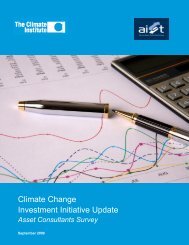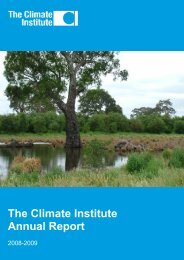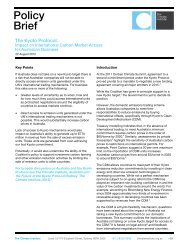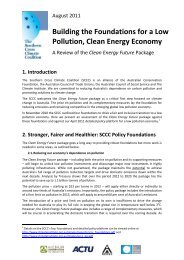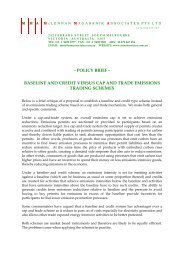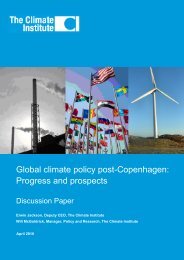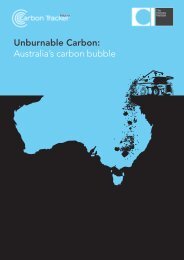Coming Ready or Not - The Climate Institute
Coming Ready or Not - The Climate Institute
Coming Ready or Not - The Climate Institute
You also want an ePaper? Increase the reach of your titles
YUMPU automatically turns print PDFs into web optimized ePapers that Google loves.
<strong>The</strong> Challenges<br />
of Preparing f<strong>or</strong><br />
<strong>Climate</strong> Change<br />
<strong>The</strong> question is less, ‘Will the sea rise 50cm?’<br />
than, ‘When will this rise occur and how much<br />
higher could it rise within the life of the asset<br />
- and what st<strong>or</strong>m surge and other impacts will<br />
accompany it?’<br />
Uncertainty is no excuse<br />
Develop flexible strategies<br />
<strong>The</strong> vulnerability of Australia’s infrastructure<br />
depends not only on the degree of climate change<br />
to which it is exposed, but on how we deal with<br />
it: how and where we build new structures, how<br />
we adapt existing ones, and how we modify our<br />
infrastructure use.<br />
<strong>The</strong>re is a widespread view that, given the<br />
uncertainties associated with future climate change,<br />
adaptation to its impacts should not be undertaken<br />
until some <strong>or</strong> all of these uncertainties are resolved.<br />
A version of this argument supp<strong>or</strong>ts focusing primarily<br />
on improving adaptation to current climate variability<br />
over preparing f<strong>or</strong> future climate change. 57<br />
However, many climatic changes are unlikely to be<br />
predicted with certainty early enough to inf<strong>or</strong>m a<br />
significant amount of today’s infrastructure planning<br />
and construction, given existing commercial drivers.<br />
A company building a p<strong>or</strong>t, f<strong>or</strong> instance, does not<br />
want to delay construction until the range of predicted<br />
sea-level rise has narrowed. As p<strong>or</strong>t construction f<strong>or</strong><br />
today’s conditions risks m<strong>or</strong>e costly retrofitting at a<br />
later date, many p<strong>or</strong>t operat<strong>or</strong>s are fact<strong>or</strong>ing in an<br />
amount of sea-level rise anyway.<br />
F<strong>or</strong> example, the development proposal f<strong>or</strong> a fourth<br />
coal terminal (‘T4’) at the P<strong>or</strong>t of Newcastle assumes<br />
a projection of sea level rise of 0.9m and a 10 per cent<br />
increase in intense rainfall. 58<br />
Similarly, areas that meet standards f<strong>or</strong> hist<strong>or</strong>ic climate<br />
conditions may become highly vulnerable under future<br />
climate change. Developing new settlements and<br />
infrastructure in these areas without recognition of<br />
the increasing climate risks places lives and assets in<br />
jeopardy unnecessarily. 59<br />
<strong>The</strong> argument that action is unneccessary in the<br />
absence of certainty also simplifies and overstates the<br />
nature of climate change uncertainty. <strong>Climate</strong> change<br />
is probabilistic and can be modelled as such. <strong>The</strong><br />
argument also underplays the risks of a m<strong>or</strong>e hostile<br />
climate. CSIRO and others note that the minimum<br />
impact from many climate change variables can be<br />
specified, while uncertainty within climate projections<br />
is overwhelmingly on the high side of f<strong>or</strong>ecasts. 60<br />
F<strong>or</strong> much maj<strong>or</strong> infrastructure, acting early is essential<br />
to avoid locking in future vulnerabilities, and can<br />
also provide benefits. Acting today may cost less<br />
than acting tom<strong>or</strong>row if it prevents locking society<br />
into infrastructure pathways that would be costly<br />
to reverse in the future. And certain actions can bring<br />
immediate benefits beyond climate risk management.<br />
F<strong>or</strong> example, resource efficiency improvements,<br />
investment in staff training <strong>or</strong> deeper supply<br />
chain analysis all contribute to c<strong>or</strong>p<strong>or</strong>ate capabilities<br />
and resilience.<br />
Ultimately, f<strong>or</strong> most infrastructure planning, the<br />
question is less, ‘Will the sea rise 50cm?’ than,<br />
‘When will this rise occur and how much higher<br />
could it rise within the life of the asset - and what<br />
st<strong>or</strong>m surge and other impacts will accompany it?’<br />
Generally, the most effective strategies f<strong>or</strong> climate<br />
preparation are those that can accommodate a range<br />
of likely climate change scenarios. Five strategies to<br />
deal with climate uncertainty are:<br />
No regrets – actions that yield benefits even in the<br />
absence of climate change. Such benefits may<br />
include increased resilience against current climate<br />
variability, <strong>or</strong> reduced exposure to supply chain shocks.<br />
F<strong>or</strong> example, efficiency improvements in water <strong>or</strong><br />
energy use can minimise the impact of sh<strong>or</strong>tages <strong>or</strong><br />
disruptions to supply while reducing costs. Better early<br />
warning and emergency management systems will<br />
also reduce vulnerability to current weather risks.<br />
Flexible/Reversible – actions that minimise the cost<br />
of being wrong about future climate impacts. <strong>The</strong>se<br />
include constructions that can be easily retrofitted <strong>or</strong><br />
upgraded, <strong>or</strong> decisions that can easily be reversed.<br />
Safety Margin – designing infrastructure to cope<br />
with the full extent of likely climate impacts. This is<br />
appropriate when the higher costs of initial construction<br />
are relatively small compared with the costs of<br />
retrofitting later.<br />
Soft – financial, institutional <strong>or</strong> behavioural tools.<br />
Insurance; inc<strong>or</strong>p<strong>or</strong>ation of regularly reviewed long-term<br />
planning h<strong>or</strong>izons.<br />
Reducing decision-making time h<strong>or</strong>izons – building<br />
61<br />
cheaper, sh<strong>or</strong>ter-lived assets.<br />
Adapting to climate change is an ongoing process.<br />
Organisations may find that their optimal solutions<br />
combines strategies as the relative merits of each<br />
solution change over time.<br />
F<strong>or</strong> example, research undertaken by AECOM<br />
investigated cost-effective responses to the increasing<br />
risk of flooding in Narrabeen, NSW, caused by sea<br />
level rise. <strong>The</strong> study found that some steps could be<br />
taken immediately while others could be deferred.<br />
Immediate steps included an early warning system<br />
f<strong>or</strong> residents of Pittwater (soft strategy; net benefit:<br />
$12 million), a 3 metre (m) levee along part of Lake Park<br />
Rd (safety margin strategy; net benefit: $0.9 million),<br />
and amendments to planning regulations to require a<br />
1m rise in flo<strong>or</strong> height f<strong>or</strong> new buildings and renovations<br />
(soft and safety margin; net benefit: $13.8 million).<br />
Widening the ocean entrance to Narrabeen lagoon to<br />
70m could wait until 2035, while building a levee f<strong>or</strong><br />
Prospect Park could probably wait until after 2100. 62<br />
Examples of this type of quantification of impacts, costs<br />
and benefits are very rare.<br />
25<br />
26



